Geosynthetics are one of the most revolutionary product groups within civil engineering, offering high-performance, cost-effective and long-term solutions to problems that arise within geotechnical, geo-environmental, hydraulic and transportation engineering. Ultimately, they allow infrastructure works to be constructed more economically, more sustainably and with greater resilience, compared to alternative solutions.
This Tensar guide offers an extensive introduction to geosynthetics, including their different types and applications, their benefits, and a few practical, real-world examples of geosynthetics in use.
Use the links below to navigate to the sections you are most interested in:
- What are geosynthetics?
- The types of geosynthetics
- What are geosynthetics made of?
- The functions of geosynthetics
- Geosynthetic applications
- The benefits of geosynthetics in geotechnical engineering
- Tensar case study: geogrids usage on the Gemas Mentakab Railway
- Tensar case study: Geotextiles reinforce South Wales rail line
- The Tensar difference
What are geosynthetics?
Geosynthetics are polymeric (plastic) man-made products used to solve geotechnical problems in construction projects. They may be planar, strips or three-dimensional structures. The different types of geosynthetics are uniquely designed to deliver varying functions such as stabilisation, reinforcement, separation, filtration, drainage, erosion control or containment of liquids. Some products may be designed to deliver a combination of functions.
The purpose of geosynthetics can be derived easily from the word itself. ‘Geo’ means earth, in the sense of ground or land, and ‘synthetic’ means manmade, in the sense of an artificial substance.
The types of geosynthetics
There are nine different types of geosynthetics, each differing in the way that they’re designed and created, as well as what they’re used for. The categories of geosynthetics are:
- Geogrids
- Geotextiles
- Geocells
- Geonets
- Geopipes
- Geofoam
- Geocomposites
- Geomembranes
- Geosynthetic clay liners
Read on to find out what these types of geosynthetics are and what they can do.
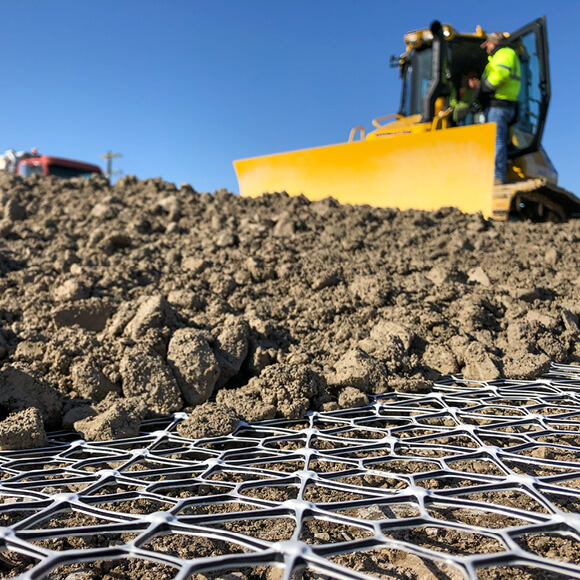
1. Geogrids
Geogrids consist of a regular open network of integrally connected, tensile elements (ribs), which may be linked by extrusion, bonding or interlacing. The apertures between the ribs are larger than the constituents. The ribs are made of polymeric materials such as high-density polyethylene (HDPE), polypropylene, or other durable polymers. The manufacturing process may involve stretching of the polymer material to orient the molecular structure, increasing strength and stiffness of the ribs.
The stiff ribs and strong junctions of a geogrid enable a high degree of interaction between the geogrid and the surrounding soil. Soil particles are able to partially penetrate into the apertures and become restrained by the ribs or confined within the apertures. Geogrids are ideal for stabilisation or reinforcement of soils, with applications such as construction over weak soils, road foundations and earth retaining structures – as such, they are one of the most commonly used geosynthetics.
Tensar produces four types of geogrids: uniaxial geogrids, biaxial geogrids, multi-axial geogrids (TriAx®), and the more complex Tensar InterAx® geogrids. Visit Tensar’s geogrids page to learn more about them.
2. Geotextiles
Geotextiles are the largest group of geosynthetics, as well as one of the earliest types to be created. They are permeable fabrics that consist of synthetic fibres such as polyester or polypropylene, and can be created as either woven, knitted or non-woven textiles. The non-woven types are manufactured from directionally or randomly oriented fibres/filaments mechanically or thermally/chemically bonded together. They can vary in strength and weight, from lightweight filter products to high strength reinforcement materials.
This category of geosynthetic, when used in association with soil, can provide a wide variety of functions including separation, filtration, drainage, protection and reinforcement, Although most commonly used as a separator before construction of roads, or as filter/separators in drainage applications, they can be used across a range of applications in engineering projects.
Tensar Basetex® is a great example of a high-performance reinforcement geotextile.
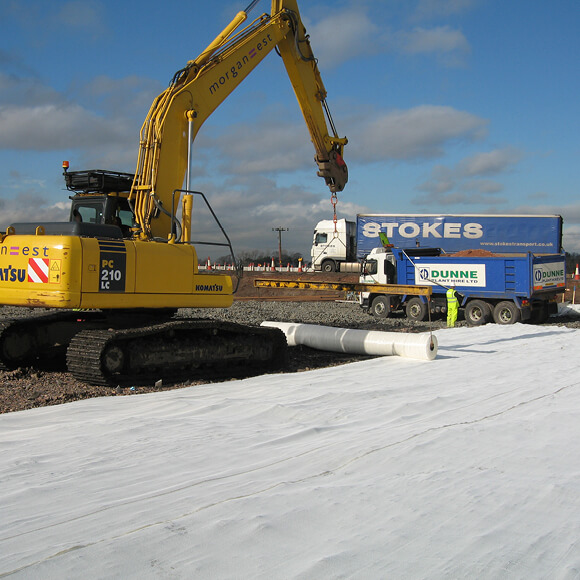
3. Geocells
Geocells are three-dimensional geosynthetic products composed of ultrasonically welded polyethylene webs or geotextile strips, that expand into a honeycomb-like structure intended to be filled with soil, sand or gravel.
The cellular structure contains and stabilises the infill material, minimising soil movement. This allows geocells to have multi-functional uses, including soil erosion protection, and stabilisation.
4. Geonets
Geonets have extruded polymer strands in a parallel design to form a diamond shaped net structure. Sometimes geonets will be laminated with geotextiles to establish them as a ‘drainage composite’.
5. Geopipes
Geopipes are any polymeric pipes, either perforated or solid-wall, that facilitate the drainage of gases and liquids on construction projects. They are most commonly wrapped in a geotextile filter, to maintain their drainage capability.
There are a variety of situations in which geopipes can be applied, including leachate or gas collection in landfill applications.
6. Geofoam
Geofoam, also known as EPS (Expanded Polystyrene), is an incredibly lightweight durable material that's can be used in numerous applications as an alternative to soil backfill. Geofoam blocks are created via polymeric expansion of the polystyrene, which produces many gas-filled, closed cells throughout the block. This design is what makes them so low in density.
The low density of geofoam makes it very useful on engineering projects as a fill material over soft or compressible foundation soils. Used as a lightweight core for an embankment, it will reduce settlements and may make it possible to avoid staged construction.
7. Geomembranes
A geomembrane is an impermeable (or low-permeability) synthetic membrane. They’re typically used as a barrier for liquids or gas, controlling the movement of fluids and providing containment on geotechnical engineering projects.
Geomembranes can be especially useful where there is the potential for leakage of hazardous contaminants as this geosynthetic offers chemical-resistant properties. Otherwise, they’re generally used as liners in landfill, mining, or agricultural industries.
8. Geosynthetic clay liners
Geosynthetic clay liners (GCL) are built using two sheets of non-woven geotextile with a layer of sodium bentonite clay sandwiched between. The sheets are bonded together (using stitching or needle punching) to create structural integrity; they’re then heat treated to secure the layers in place.
GCL’s provide a faster more convenient alternative to traditional clay lining of containment ponds. These materials have an added advantage in that the sodium bentonite layer has swelling properties. As such, clay liners offer a degree of self-sealing that reduces leakage. GCL liners benefit many geotechnical applications, including waste treatment and landfill.
9. Geocomposites
Geocomposites combine of two or more of the geosynthetic types discussed above. Combining the features of each geosynthetic creates a product with more benefits than any individual product type, particularly useful in drainage and containment applications and some road foundation situations. For example, Tensar combines stabilisation geogrids with separation/filtration geotextiles for use in road and rail foundations where fine soil migration may be an issue. Take a look at the Tensar TriAx TX-G product page for an example of a geocomposite.
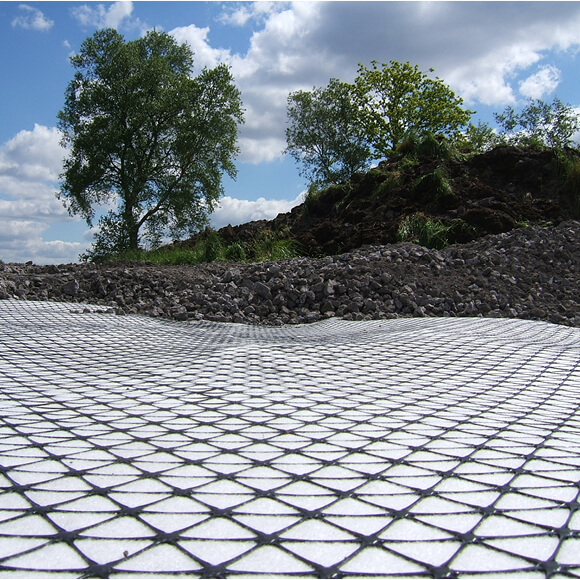
What are geosynthetics made of?
Geosynthetics can be made from different types of polymers, however the most popular include high density polyethylene (HDPE), polypropylene (PP) and polyester (PET). The polymers selected are highly resistant to biological and chemical degradation. Manufacturers incorporate additives or modifiers to the polymer blend to impart desirable characteristics such as weathering resistance and uv resistance. Other polymers, such as aramids or polyvinyl alcohol (PVA) are used for highly specialised applications requiring very high strength.
The functions of geosynthetics
Geosynthetics serve eight main functions in relation to earth materials such as soils and rocks (hence the prefix, ‘geo’); these vary from the stabilisation of soils to containment of liquids. Some products are designed to deliver more than one function, helping to save time and money by reducing the number of products needed.
Let’s have a look at each geosynthetic functions and what they offer.
a. Stabilisation
Where geosynthetics are used to stabilise granular soils, this typically occurs via an interlocking mechanism. With geogrids, for example, the apertures between ribs allow aggregate to strike through and interlock, confining the aggregate material. Provided that the geogrid has strong junctions, and ribs that offer high stiffness at low strain, movement of the soil particles can be minimised, improving the mechanical behaviour of the soil. This mechanical stabilisation creates a composite layer that is stronger and more resistant to deformation.
Geogrid stabilisation is common in roadway foundations and in working platforms that will endure heavy loads, as it increases bearing capacity and reduces deformation under load. You can learn more about the stabilising power of interlock in this Tensar article.
b. Reinforcement
Geosynthetics that have high stiffness and high strength, such as certain types of geogrids and some geotextiles, can improve the mechanical properties of a soil mass by adding a reinforcing element that provides increased strength and deformation resistance.
The use of geosynthetics providing a reinforcement function enables engineers to build embankments on soft foundations and create earth slopes with steeper slope angles.
c. Drainage
The drainage function of geosynthetics allows groundwater or other fluids, to be collected and pass through less permeable soils. Drainage geosynthetics can be used to dissipate pore pressure below embankments, intercept groundwater in slopes or behind structures, and provide edge drainage to road pavements.
Drainage geosynthetics are usually geocomposites, typically combining a geonet drainage core with one or more layers of geotextile. They are able to pass water (and other liquids or gas) through their structure to a collector or open space.
Good drainage is essential for roadways as water under the surface can lead to softening of subgrade soils and eventual loss of strength in the road structure. Therefore, geosynthetics can commonly be found in roads and railways, behind retaining walls, as well as below embankments where less permeable soils exist.
Visit our guide on pore water pressure for more on the importance of drainage.
d. Erosion control
Erosion control is the practice of limiting damage to land due to the action of wind or water. Once the top layer of land is eroded, re-growth takes a long time, and this is where erosion control geosynthetics come in to give nature a helping hand.
Erosion control geosynthetics, typically, in the form of multi-layered mats, reduce soil erosion caused by impact of water droplets and surface runoff. They are rolled onto a surface and pegged in place. Some products combine synthetics with natural materials to provide enhanced moisture retention to encourage vegetation growth.
In areas where land is exposed to water flow or rainfall, erosion control geosynthetics are ideal for protecting the top layer of soil, encouraging vegetation to grow and preventing soil loss in the future. This is particularly common around areas of water and embankment slopes.
e. Filtration
Soil particles, particularly finer particles, can be transported by water passing through soils. Filtration geosynthetics, usually geotextiles, are designed to retain soil particles on the upstream side of the filter, while allowing water to pass freely through. Even fine soil particles can be retained due to the ‘bridging’ effect of larger particles on the upstream side of the filter. Filtration is therefore most effective with one-directional water flow.
The filtration properties of geotextiles can be designed by varying the type and density of fibres, and the thickness and structure of the fabric. They are often combined with a drainage core in the form of a geocomposite. Suitably engineered products may be used to prevent soil migration into drainage aggregate layers or gravel filled drains, or for critical applications below riprap protection in river or coastal works.
f. Separation
To function as a separator, the geosynthetic must prevent soil with different particle size distributions from intermixing and causing the structural integrity to fail.
Separation is a required function in many applications, however it is vitally important to the layers of roads and pavements. Geotextile separators are routinely used below road and rail construction, in isolation or combined with a geogrid in the form of a geocomposite.
A geogrid can prevent expensive subbase material from punching into the soft subgrade. When a well-graded subbase is stabilised with a geogrid the geogrid/soil composite layer can prevent finer grained soil from migrating up into the subbase. When soil moisture levels are high, a geocomposite with geogrid and separator/filter properties may be used.
g. Barrier
Geosynthetics can be used to provide a relatively impermeable barrier for the containment of fluids or gasses. There are several forms of barrier geosynthetic. Geomembranes manufactured from polyethylene, polyvinyl chloride (PVC) or rubber, offer high impermeability. Geosynthetic Clay Liners (GCL’s) are an alternative with a degree of self-healing capability.
Geosynthetic barriers are used for fluid containment in mining, industrial and agricultural applications. They are also used in conjunction with drainage composites in waste containment and landfill capping.
h. Protection
Geosynthetics can perform a protection function by acting as a cushion to a sublayer. Non-woven geotextiles can be designed to protect geomembranes from puncture damage during placement of covering fill. Geonet type materials can be used to provide protection to coated pipelines during backfill operations.
Geosynthetic applications
Geosynthetics can be applied in a wide variety of geotechnical applications. Not to be confused with the functions discussed above, applications of geosynthetics are the situations in which they can be utilised, providing solutions to specific geotechnical problems or challenges in an engineering project.
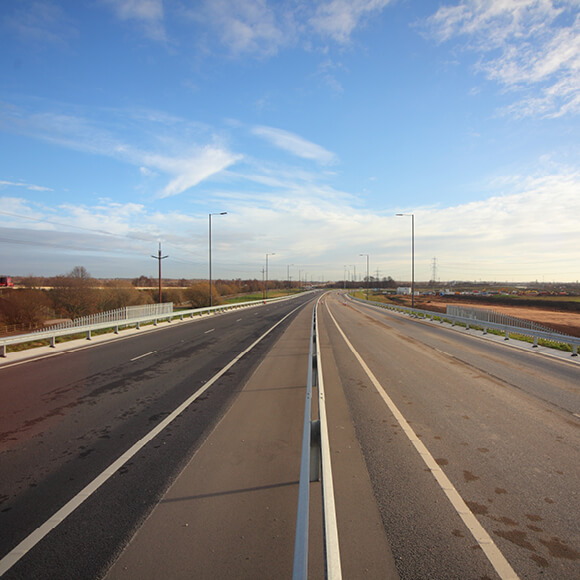
a. Roads, pavements & trafficked areas
Geosynthetics are often applied in areas such as roadways, railways, airports and more.
For roads and runways, they’re primarily useful in stabilising and separating unbound pavement layers. However, they can also be used to address issues with the underlying soil, or in providing side drainage.
Geogrids have been used to aid construction and enhance the performance of roads over soft ground since the 1970s. More recent advancements have led to their increased use to enhance the service life of paved roads, reducing whole life costs. Visit this page on roads, pavements and trafficked areas to discover more on how Tensar products improve road construction projects.
b. Rail trackbed improvement
Geosynthetics can be applied to solve a variety of problems below rail track. Stabilisation geogrids are routinely used to increase the bearing capacity and stiffness of the trackbed over areas of weak soils. They can also be placed below the ballast layer to control lateral migration and deterioration of the ballast particles. Differential stiffness issues associated with transitions from rigid to flexible foundations can be addressed with geogrid stabilised transition zones. Visit this page on rail trackbed improvement to discover more on how Tensar products improve rail track maintenance and construction projects.
Geotextile separators and drainage geocomposites are used to control moisture related problems, while highly specialised sand filled geotextile mats can replace sand filters below trackbed.
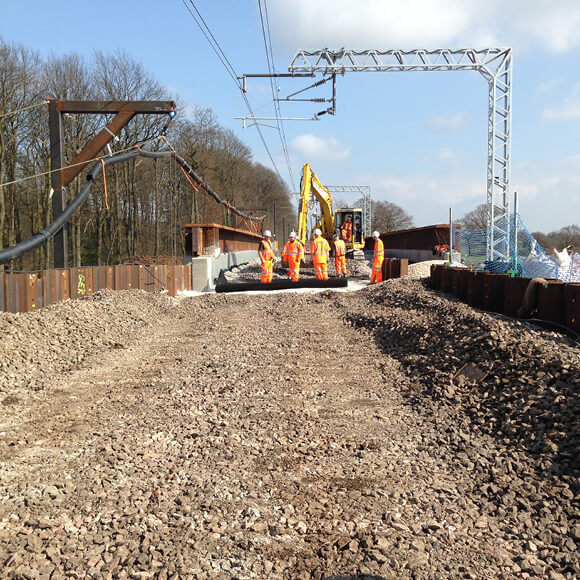
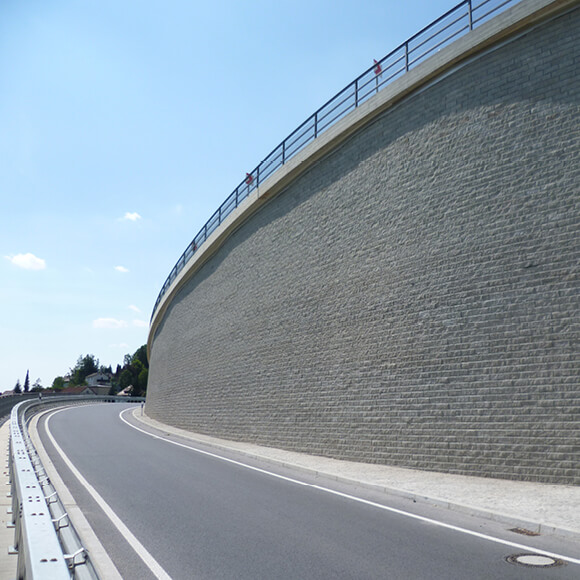
c. Earth retaining structures and steep slopes
Reinforcing geogrids and high strength geotextiles can be used to construct steepened slopes that have a reduced footprint compared to natural slopes. Geogrids are also used to construct reinforced soil walls and bridge abutments. These are quicker and cheaper to construct compared to concrete or piled retaining walls.
d. Embankment foundations
The construction of earth embankments over weak soils presents challenges that can be addressed by the use of geosynthetics. Over-stressing of the foundation soil as construction proceeds can result in a deep rotational failure. The inclusion of geosynthetic reinforcement in the base of the embankment can maintain stability against this failure mechanism.
Three-dimensional cellular mattress systems, such as Tensartech® Stratum®, provide reinforcement at the base, but in addition, the inherent stiffness of the cellular mattress distributes load and influences the settlement profile. Learn more about the benefits of a cellular foundation mattress in this Tensar article. Geosynthetic wick drains, driven deep into the foundation soil can relieve excess pore pressure as the embankment rises, enabling more rapid construction.
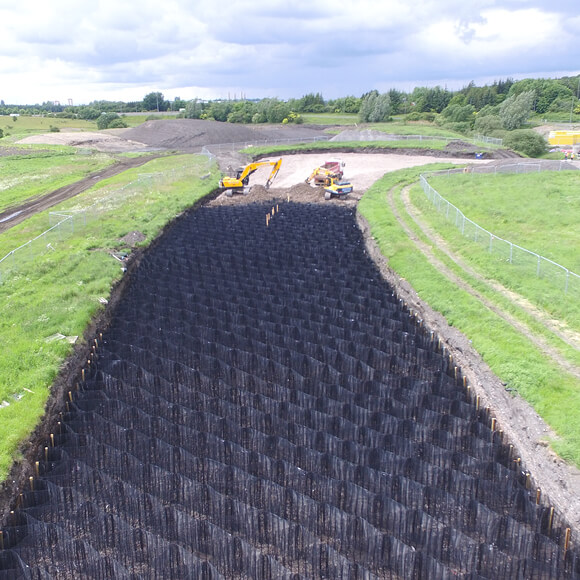
e. Drainage systems
Geosynthetics are well established for use in drainage systems, for filtration, separation and water movement. Geocomposite drainage materials can replace aggregate filled ‘French drains’ alongside roadways or as slope interceptor drains. They also provide drainage and pore pressure relief behind buried structures. Filter geotextiles are used to prevent contamination of perforated drainage pipes and drainage aggregate layers, while prefabricated vertical drains relieve pore pressure below embankments, accelerating construction.
f. Containment and landfill
New landfill sites can be lined with layered geosynthetic systems comprising geosynthetic protection, drainage composites and impermeable barriers. Capping of landfill sites will utilise drainage composites and barriers for gas containment and venting. The mining industry uses impermeable membranes to line tailings lagoons, while geogrids and geocomposites may be used to stabilise lagoon capping after use.
The benefits of geosynthetics in geotechnical engineering
Correctly designed and applied geosynthetics have the potential to provide many benefits. Their use has been proven over time in multiple applications, soil types and climate zones. Benefits are wide ranging, from enabling access over ‘impossible’ ground to extending the life of roads. From reducing the volume of aggregate usage in construction to protecting waterways and coastal areas from erosion. Here are some of the benefits of using geosynthetics:
- Improved lifespan: maintaining high performance for an extended lifetime.
- Cost savings: reducing the quantities of imported fill, aggregates and waste, accelerating construction, providing more efficient design options
- Simplicity of construction: straightforward and fast installation using well proven methods.
- Strength: in reinforcement applications they have a high strength to weight ratio.
- Durability: highly resistant to weathering, biodegradation and chemical contaminants. As an example, allowing the use of lower-cost non-standard fill in reinforced soil structures.
- Customisable: can be tailored to the needs in terms of structure, size and composition.
- Design creativity: new solutions, new construction methods and new ideas.
- Environmentally beneficial: can enable alternative construction methods that reduce material volumes, transportation and construction methods – and their associated carbon emissions, to offer a net environmental benefit.
- Resilience: geosynthetics have enabled new and innovative solutions that help safeguard infrastructure against the effects of environmental change, such as higher rainfall, flooding, and changes to freeze-thaw weathering and degradation of roads.
- Sustainable: geosynthetics like geogrids can improve the service lives of structures, cut maintenance requirements and reduce whole life costs. To learn more, see this Tensar article 'What role can plastics and geogrids play in sustainability?’

Tensar case study - Geogrids usage on the Gemas Mentakab Railway
Along a stretch of the Gemas to Tumpat railway, passing trains had caused fine grained soils to contaminate the ballast layer, in turn causing track alignment issues and track settlement The Public Works Department in Malaysia were in search of a cost effective and time considerate solution.
Geosynthetics, in this case Tensar geogrids, were the perfect solution for replacing the previous geocells used. A single geogrid layer was used below the ballast layer to provide life-time confinement and stabilisation, further benefiting from rapid installation and material cost saving compared to the typical geocell solution.
This case study is a model example of where the right type of geosynthetic (geogrid vs geocell) needs to be considered when approaching a particular geotechnical engineering problem.
Visit this Gemas Mentakab case study to learn more, or the Tensar TriAx geogrid® page to learn more about the geosynthetic used.
Tensar case study - Geotextiles reinforce South Wales rail line
In this success story, Tensar used a combination of geosynthetic reinforcement systems to build a steep-sided rail overbridge embankment. As a part of Network Rail’s electrification of the Great Western Mainline, the client needed a new embankment, up to 5m high with a natural vegetated finish.
This was on top of poor ground conditions with weak clay deposits, as well as the site being located within a Site of Special Scientific Interest (SSSI) in South Wales. Utilising Tensar’s high-strength Basetex® geotextile alongside the Tensartech® Greenslope™ system, the embankment was built at a 70℃ slope with the geotextile in place to reinforce and support the embankment for its 120-year design lifespan.
Visit the Green Lane Rail case study to learn more.
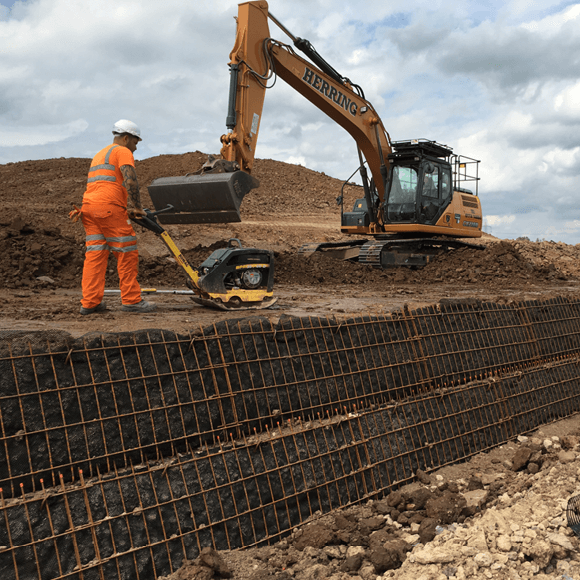
The Tensar difference
Tensar offers proven, high-performance geosynthetic products and systems, primarily including geogrids, that help you deliver your project with confidence. Not only do they provide significant benefits over alternative solutions, but they’re also widely accepted by client authorities worldwide and have had their performance proven and quantified by extensive research and field trials. What really makes Tensar different is the level of service, expertise and support available.
The range of geosynthetic products and systems Tensar offer includes:
- Tensar® InterAx® Geogrids
- Tensar® TriAx® Geogrids
- Tensar® TriAx® Geocomposites
- Tensar® Uniaxial Geogrids
- Tensar® Biaxial Geogrids
- Tensar® Basetex® Geotextile
- Tensartech® Wall and Slope Systems
- Tensartech® Stratum System
Get in touch with us today via email to find out more, or explore more of our products on our solutions and their applications. Tensar® Biaxial Geogrids


